I talked about my use of goal-less problems on my physics semester exam. The essential idea is that the question is actually just a description of a situation. The student’s job is to model the situation as best they can using the physics they know. First step: say which models apply and why. Second step: draw (and annotate) the graphs/diagrams that go with those models to represent the situation. Third step: use the diagrams to analyze the situation.
“This problem doesn’t ask for anything.”
We start to plant the seed of this concept in the third unit (Constant Acceleration Particle Model) with “baby goal-less problems.” At that point, they can really only draw the kinematics graphs. And if there is enough information to solve the problem, they can probably only calculate about two pieces of information about the problem. They usually feel uncomfortable that there isn’t a specific question asked, but they also soon realize that there aren’t a lot of solvable questions to ask given the information. They just don’t know a lot of physics yet. I tell them that later in the year I will be able to give them a situation like these and they will fill up an entire page with physics, and that seems unlikely to them (at the time).

By the next unit (Unbalanced Forces Particle Model), they start using this tool to compare small changes in a situation. The honors class starts with a block sliding down a ramp with various descriptions given of the motion and amount of friction. The regular class starts with a block pushed then released along floors with varying amounts of friction.

At some point, I started making the background of the page a 50% opacity fine graph paper to try and really encourage them to use careful diagrams/graphs as part of their solution.
What do students actually write?
The second half of the semester exam presented students with 5 goal-less problems and asked them to choose 2. Here are a few of those problems. I chose some of the most thorough responses as well as some sparser ones.
A couple uses of goal-less problems
One use that I really like is starting a new unit with goal-less problems when the new model is really an application of old models (projectile motion is constant velocity and constant acceleration, uniform circular motion is a special case of unbalanced forces). It all but requires them to make connections between what they learned earlier and the new special case that we are considering, and it reinforces the idea that they can model new situations using the tools that they have already developed.
Here is the start of the Projectile Motion Particle Model packet. In Honors Physics, I let them dive in with this without trying to prime them for free fall at all. With the regular class, we spent around 30 minutes analyzing the first half of take 1 of Dan Meyer’s basketball videos, drawing graphs for the motion of the basketball, and generally defining free fall as the-only-force-acting-is-Fg. We kept our discussion very qualitative leaving the quantitative analysis to happen when they struggled through the first line-up of problems.

The next two questions are identical, but the ball is changed to an aluminum ball then to a ping pong ball. After that, the ball is rolled off of a 1.5 m tall table, then launched off the end of the same table. In both classes, when they started to calculate numbers on the various problems, they had lots of disagreements at their tables and started looking for objects to roll and drop to see if their answers could actually be true.
And later, in the Central Force Particle Model unit in my honors class, we started out with spirited discussions about how to model this situation (after we had played with vectors and geometry a bit to derive some relationships for objects going around a circle at a constant speed):

Another great use for goal-less problems this year has been as reassessments. Usually, I take a piece of paper, draw a picture onto it, label it with some numbers, and ask them to show me the skills the want to reassess. It usually keeps them from cherry-picking the skills because they generally have to show them in context. If they are prepared, they can demonstrate mastery on a lot of objectives at the same time (and I don’t need to carry around a ton of problems specifically tailored to each objective).

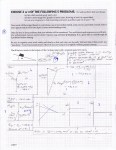

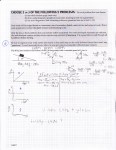

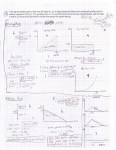
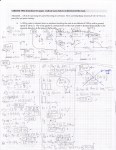
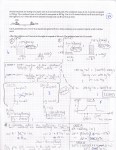
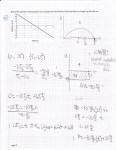
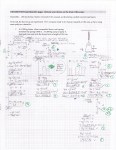
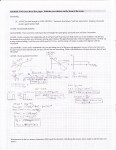

Kelly,
This is great. I’ve found goal-less problems to be similarly useful, and the kids love them. But your kids’ work is truly amazing.
Thanks! I’ll pass that on to them when they get back from spring break in a couple of weeks.
I’ve been meaning to try to start this. How do you begin so that you get anything decent?
Hi Bryan,
For the first couple of units with these problems, the first goal-less problem starts with a lot of structure. It gives the statement, then has parts (a), (b), and (c) spaced out on the page. The (a) is “What models apply to this situation and why?” The (b) is “Draw at least four diagrams/graphs to illustrate the situation. Choose the diagrams and graphs that you find most useful.” The (c) is “Using the models you have chosen, solve for any unknown quantities. Use more than one method to find the same answers whenever possible. Show your work and use units. Alway start with a variable expression.”
We do a lot of whiteboarding. And we talk a lot about how everyone does a pretty cruddy job at everything the first few times they try it. After they’ve done a few, I usually do one on the board for/with them. We talk a lot about how they aren’t going to learn much physics by watching me do a problem, but that they might get some ideas about how they can organize their work when they are doing a problem.
Annotating the graphs is key. I need to add that explicitly into the early instructions next year. Annotate first with symbols (the “run” on a v-t graph could be called delta-t, the rise might be called vi or delta-v, depending on the shape, etc). Then add in any numbers that you know next to the symbols (so vi becomes vi=2 m/s). Then it becomes pretty easy to use the graphs. Oh, and drawing qualitative graphs that are annotated is also key. They always want to draw quantitative graphs for me at first, and if they don’t know enough values, they fall apart. Once they get into the habit of drawing qualitative annotated graphs they start to see how they can use the graph to find the information that they don’t know.
If you try some, let me know how it goes!
I base a lot of my packets off of Matt Greenwolfe’s More Models in Modeling materials (scroll down to #3). You can also easily create goal-less problems from book problems by just removing the question.
Good luck!
I’m kind of in love with this and sharing it with all the physics teachers I know 🙂 Thanks for sharing it with us, and I look forward to learning more!
Love the idea. I’ll actually be using a lot this in a college physics “studio” course next fall. I like it because it focuses on the fact that in science we are modeling the world to understand it, not just to get numerical answers to questions. The other things I’ve used is to give an equation or a free body diagram, and ask them to draw the situation. This is like reverse modeling – what situation could this equation model. Doing the forward and the reverse process does something to the brain.
This is pretty amazing stuff. I need to ponder whether something like this could be viable in a math course.
[…] Goal-less problems: Kelly has worked hard to develop a willingness in her students to take on open-ended problems that force them to identify the questions for themselves, and do a complete analysis of the situation at hand. you’ll be amazed at what her students can do with this. […]
[…] going to be a goal-less problem. I’ve wanted to try these since I first read about them on here and here. They appear to have originated from Paul D’Alessandris (ref), but I can’t find […]
[…] possibility for a capstone can be completing a goal-less problem using a livescribe pen or screencast, making use of many of the great ideas that Andy […]
[…] One of the things I do like about the flipped classroom I teach in is the use of goal-less problems. […]
[…] I discovered goal-less problems. (Thanks, Kelly!) For the first day of class, I turned Dan Meyer’s boat in the river […]
[…] tell them where to start and let them play around a bit more. Next year I plan to do more goal-less problems, which will make this sort of exercise easier, I believe. I did have one group start looking into […]
[…] of John’s posts. I began to follow Kelly O’Shea’s example and challenge my students with goal-less problems that allowed them the opportunity to really stretch their understanding of the […]
[…] was also interesting that a number of students connected modeling with goal-less problems, of which I have only done a few. I’ll be looking more into those in the future, that much is […]
[…] it as a goal-less problem (which I haven’t done a ton, but I will be adding more; thanks to Kelly O’Shea for introducing me to this […]
[…] that talk about open ended questions on physics tests. A great example of this can be found here at Physics! Blog! I think the idea behind this is to allow the student to showcase everything that they’ve […]
[…] Earning a grade above 90 requires some sort of synthesis. For Mark and Kelly, this has meant doing an exceptionally good job on goalless problems on the exam. […]
[…] who are implementing these ideas – particularly Dan Meyer, Frank Noschese, Brian Frank and Kelly O’Shea. Rhett Allain’s blog Dot Physics includes many great examples of this kind of […]
I really like the idea of putting graph paper behind the problems. How exactly did you do that?
I have a PDF of graph paper and drag it into my Pages file. Then I make it almost the size of the page, set it to floating, and make it not wrap text around it. I set it to 50% opacity and make it the background (then sometimes make the characters of text have a white background so that they are more legible on the graph paper). Hope that helps! 🙂
So when making your graph paper on the page, is there a way to actually get it to be a set size? I have been trying to recreate this in MSWord using tables for the boxes, but they don’t allow me to make them exact enough… I’d love for my boxes to be 0.5cm but they just aren’t perfect enough for me… I know about inserting a picture, but then it can dragged to different sizes and I fear i won’t get any closer to my perfectly spaced 0.5cm boxes…
PS – Love your site and it has been a lifesaver in this first year of modeling/SBG…
I don’t use Word, but here’s what I think might work: if you make a graph paper image so that the grid is to the correct scale when the image is a certain size (which you know the size of), then tell the program to make the image that exact size in the background of the page. I know that would work in Pages, so I assume Word should let you do something similar. Hope that helps!
[…] I talked about my use of goal-less problems on my physics semester exam. The essential idea is that the question is actually just a description of a situation. The student's job is to model the sit… […]
[…] goal-less problems looks like a cool idea https://kellyoshea.wordpress.com/2011/03/05/goal-less-problems/ […]
[…] I presented my students with a goal less problem (Thanks to Kelly O’Shea for the great idea) as a culminating activity to a section on the […]
[…] I like to make changes in the way I run classes also. Slow and steady changes. There are two things I would like to try, the first is the goal-less physics problem. Kelly O’Shea has a very nice description of this on her blog[9]. […]
[…] today fit hand-in-hand with another idea that I’m in love with that I got from @kellyoshea: goal-less problems. The basic idea is that instead of giving students a situation and asking them to solve for various […]
[…] I talked about my use of goal-less problems on my physics semester exam. The essential idea is that the question is actually just a description of a situation. The student's job is to model the sit… […]
I have used a few “goal-less” problems in the past, inspired by your ideas!
This year I finally have the freedom to move my physics class to SBG. So with that I had the thought to use goal-less problems as a choose your own adventure in terms of kids satisfying or completing standards they are missing or haven’t done well at yet. Maybe let the kids pick 2-3 standards that they want to be assessed on and that they think the problem can be used to demonstrate.
[…] had been working on. I choose one of them; a goalless problems as described by Kelly O’Shea here. I like these because they can get us away from specific types of problems and pose some really […]
[…] goal-less problem provides students with a scenario but no question. Kelly O’Shea has a great blog post about goal-less problems in physics class. I love combining goal-less problems with standards-based […]
[…] combined the diagrams with calculations to solve more traditional word problems. I gave them a few goal-less problems, which simply describe a situation without asking for anything in particular. My students […]
[…] After the quiz, students tackled some acceleration problems using graphical solutions, including a goal-less problem and what Etkina calls Equation Jeopardy, where students are given an equation, and have to […]
[…] After the quiz, students tackled some acceleration problems using graphical solutions, including a goal-less problem and what Etkina calls Equation Jeopardy, where students are given an equation, and have to […]
[…] I use transfer tasks and in particular, goal-less problems. I will hold up a goal-less problems to the toughest of any other physics 11 or 12 test. Students […]
[…] worked on some goal-less problems for Newton’s 2nd Law in two dimensions. I was very explicit with my students that I use them […]
[…] stakes in my class, I had students do some whiteboard speed dating to go over yesterday’s goal-less problems. There were a lot of great conversations; the best part was how many students I heard asking […]
[…] more group-worthy and conversation-worthy pieces in my chem classes. I really want to incorporate goal-less problems in my physics classes (and it seems quite doable for both me and my students), and I would love to […]
[…] interpret diagrams before I ask them for an answer. Its tempting to see what would happen with a goal-less TIPERs […]
[…] With this in mind, and some inspiration from Kelly O’shea’s Card Sort activity, and the Goal-less problems that I am fond of , I created my own “Matching […]
[…] from a launcher, you could ask the student to come up with their own question. (This is called a goal-less problem.) Or you could give them a solution with a mistake in it, and ask them to find the mistake and fix […]
[…] O’Shea, a long time ago, blogged about goal-less questions. I have used them before, and then I forgot about them during my […]